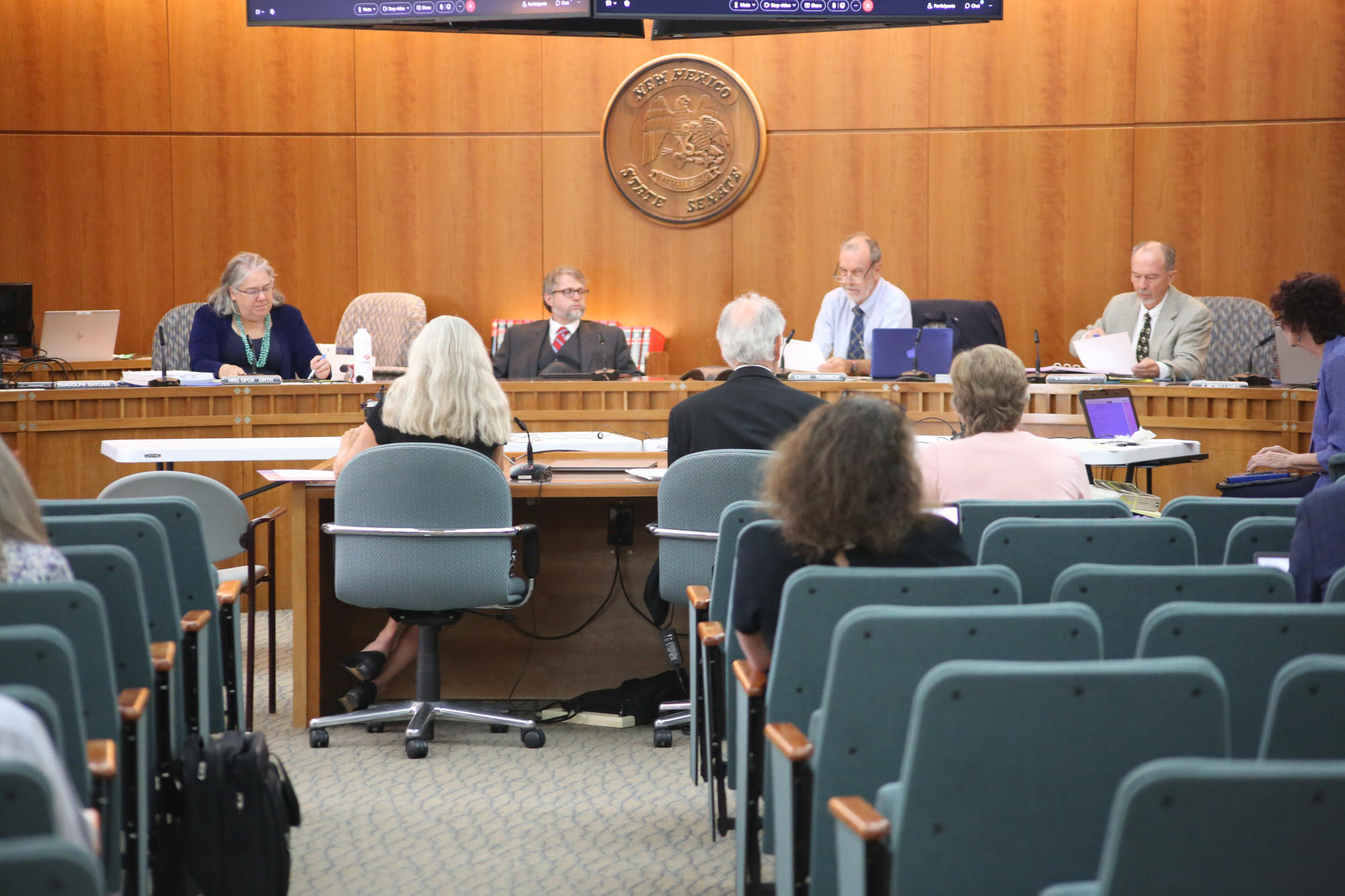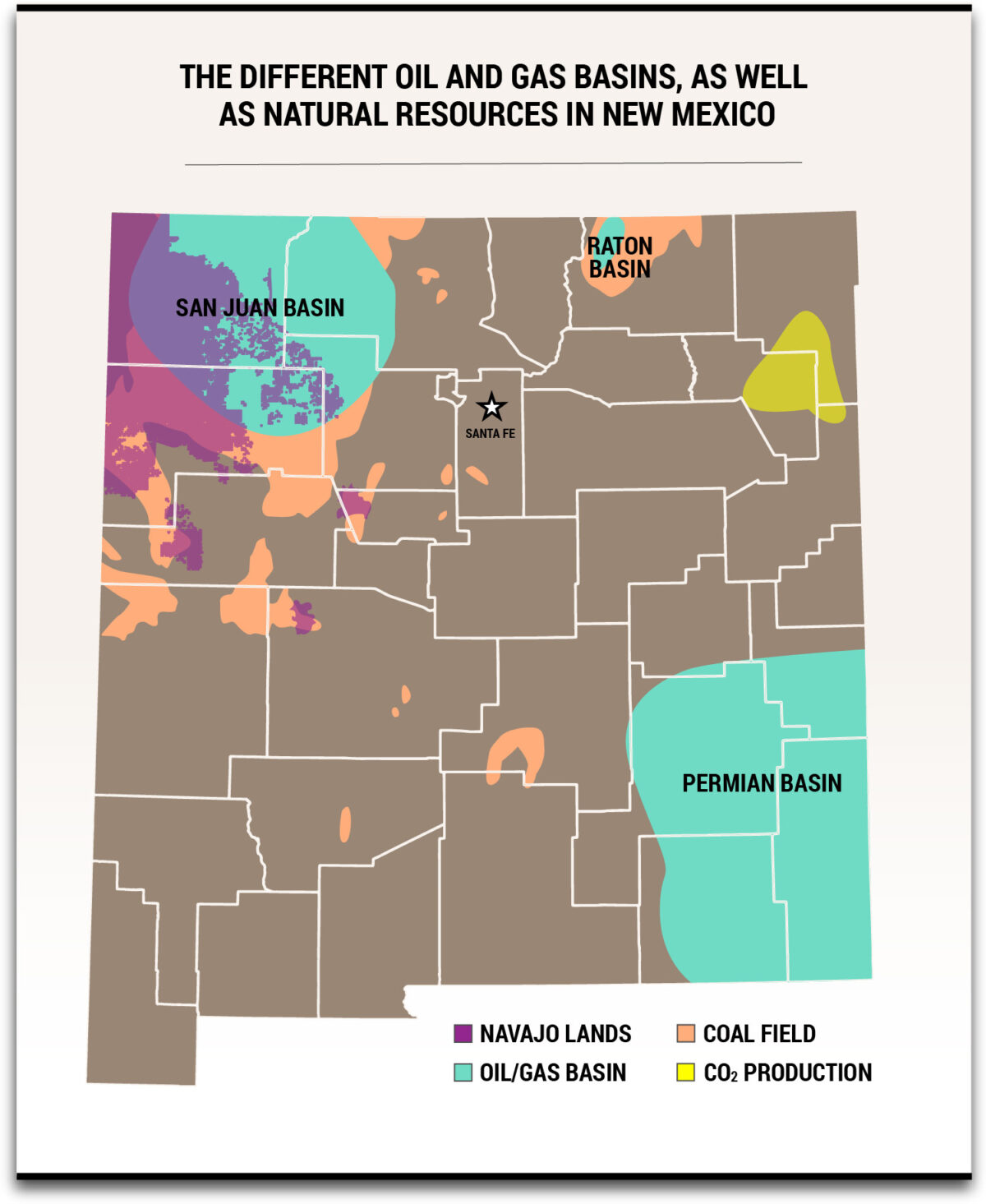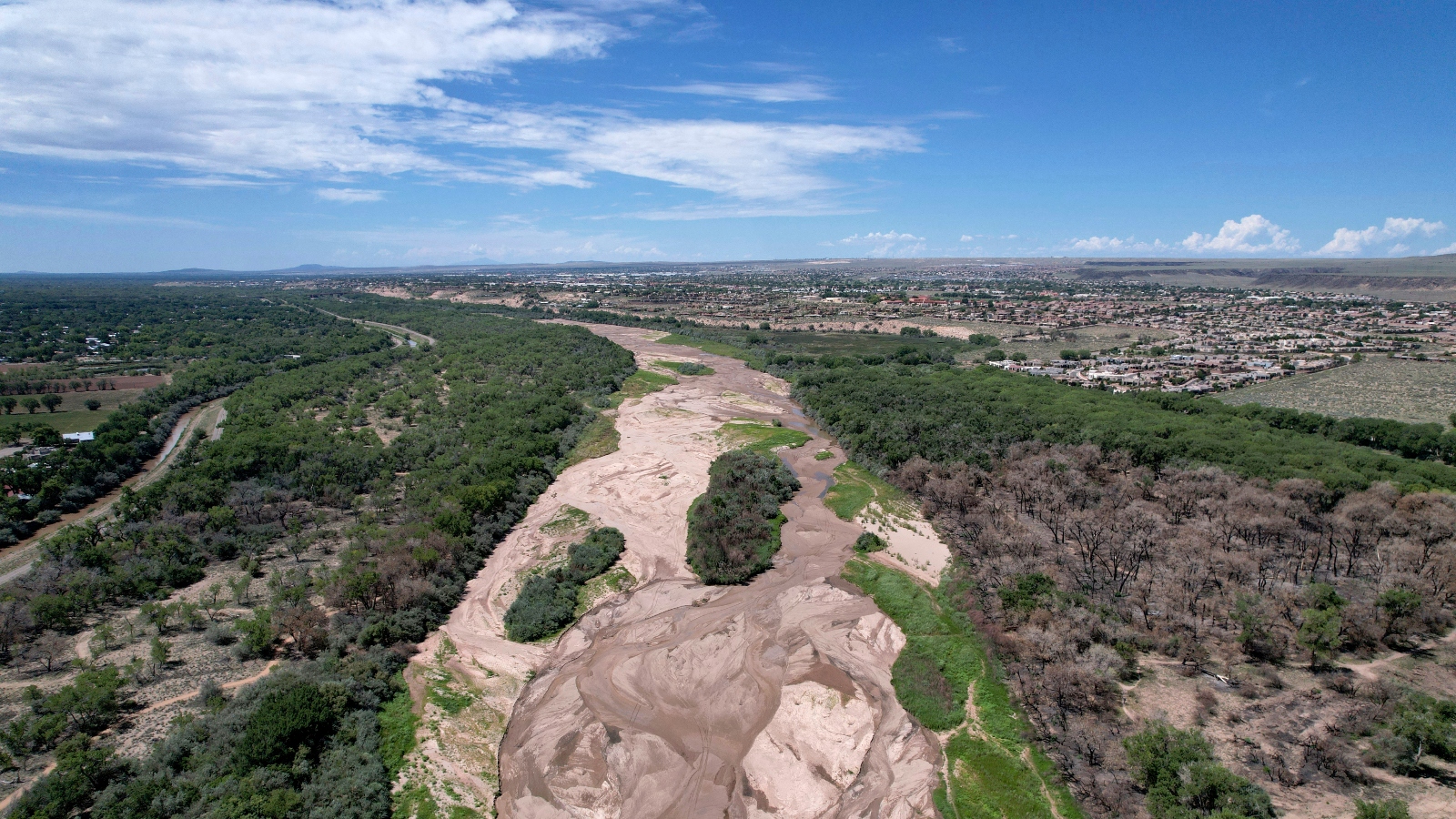This year, the New Mexico Water Quality Control Commission held a hearing in Santa Fe to seek public input on regulating wastewater discharge from the oil and gas industry. It ended up dealing a blow to Governor Michelle Lujan Grisham’s ambitious proposal to reuse the water for alternative energy development.
Under the proposal, which was announced a few months earlier at the 2023 United Nations Climate Change Conference and dubbed the “Strategic Water Supply,” the state would buy both natural brackish and oilfield-produced water, contract with private companies for treatment or cleaning, and then provide the cleaned water to so-called green industries like solar and wind energy and electric vehicle manufacturing. The $500 million investment, Lujan Grisham said at the U.N. conference, would help “strengthen our climate resiliency and protect our precious freshwater resources.”
But the majority of the public who attended the hearing or submitted written comments opposed any discharge of either treated or untreated produced water, with some calling the water toxic and contaminated. New Mexico Water Quality Control Commissioner Katie Zemlick summarized the concerns of many citizens: Given the lack of reliable data on the chemicals found in the industrially produced water, “Why would we want to move forward with applications that could potentially interact with ground or surface water?”
Some environmental and Indigenous activists also panned the proposal, with activists calling it a “false solution” that funnels money to the oil and gas industry. And during the 2024 legislative session, a bill to fund the project received little support from lawmakers, and died in committee.

Adam Ferguson/Santa Fe Reporter
All the while, the state hasn’t give up: The New Mexico Environment Department (under which the Water Quality Control Commission falls) collected information from the private and public sectors on treatment and industrial reuse of produced water, a preliminary step before requesting and accepting proposals under the plan. And at the hearing they pursued new rules for the use of produced water in pilot projects.
Mike Hightower, program director of the New Mexico Produced Water Research Consortium, a partnership between academia, government agencies, national laboratories, the private sector, and the state, testified that “the data available on produced water overwhelmingly shows that it can be treated and used safely.”
Other oil-producing Western states are also grappling with how to manage increasing volumes of produced water, given intensifying drought and dwindling storage options.
New Mexico is at the center of the debate because of the lucrative Permian Basin, which extends from West Texas into southeastern New Mexico. The Permian is the nation’s most productive oilfield, accounting for over 40 percent of total U.S. oil production. It also generates the most wastewater — more than 15 million barrels per day in 2022, over 10 times more than the next-highest producing basin.
James Kenney, the New Mexico Environment Department secretary, emphasized in an interview that the state is not proposing reuse for drinking water or agriculture. But using produced water for hydrogen fuel development or solar projects, he said, “seems like a great way to offset freshwater use.”
Currently, he added, most produced water is injected back underground, and it’s “a real missed opportunity” not to reuse it.
But public health advocates are concerned. Ted Schettler, science director at the Science and Environmental Health Network, a nonprofit group, said that “produced water is highly toxic.” In addition to known carcinogens like formaldehyde, he said, produced water presents “reproductive hazards, developmental hazards, neurotoxic hazards” to humans.
The Permian wastewater surge is the result of a boom in fracking — an extractive technique in which fluid is pumped into wells at high pressure to break open tight rock formations and release oil and gas deposits. As of 2022, around 95 percent of the Permian’s oil and gas wells were horizontal wells, which extend horizontally below the surface, and typically fracked, up from around 20 percent in 2011. Along with hydrocarbons, large quantities of water are brought to the surface with a host of naturally occurring substances, like salts, metals, and oil and grease, as well as chemicals added by fuel companies.
The region’s enormous volume of wastewater and “high current and projected levels of water scarcity makes the Permian a key location” of regulation and research, according to a 2023 report from the Ground Water Protection Council, a nonprofit composed of state groundwater regulatory agencies.
For now, regulation is left to Western states under the federal Clean Water Act, which authorizes beneficial reuse of water “of good enough quality” in states west of the 98th meridian, which roughly demarcates the arid West.

Anson Stevens-Bollen/Santa Fe Reporter
Some states have already approved some reuse of produced water outside oilfields, though not for green energy and without the significant investment proposed by New Mexico. In California, produced water is used for irrigation in the Central Valley; in Wyoming, it is used for livestock watering and irrigation; and in Pennsylvania, it has been approved for discharge into the Susquehanna River.
In Texas, meanwhile, pilot projects are being conducted with cotton irrigation, and the state has permitted discharge to streams and rivers if it meets water quality standards. Texas and Colorado have also created produced water consortiums to study treatment and reuse outside oilfields.
Some scientists are calling for more federal oversight of such projects. “It’s almost guaranteed that if the particular state does not require much more rigorous testing, there are going to be hazardous chemicals that are going to be spread on the land, or make their way into waterways,” said Schettler.
“I think it’s pretty clear that the current regulatory landscape is not adequate to truly protect public health or the environment because of all these unknowns,” he added.
Taimur Shaikh, a senior policy adviser for the Environmental Protection Agency in the New Mexico region, and an adviser to the state’s produced water research consortium, emphasized that the EPA’s involvement in state consortiums working on regulations is minimal: “We’re trying to be engaged in an advisory capacity,” he told Undark. “But we are definitely not trying to steer any of them.”

Adam Ferguson/Santa Fe Reporter
Meanwhile, produced water is “a very valuable water resource,” said Pei Xu, associate director for research and technology at the New Mexico Produced Water Research Consortium. But, she added, it’s necessary to ensure that the treated water “will not cause any risks to human beings and to the environment.”
Permian produced water has been found to contain the naturally occurring radioactive metals radium and uranium; other metals like lithium and iron; ammonia; and volatile organic compounds including benzene and toluene. Oil and gas companies also add chemicals to their drilling fluids, including acids to dissolve minerals, biocides to kill bacteria that cause corrosion, surfactants to make the fluid thicker, and polymers to minimize friction during drilling operations.
Hightower, the consortium’s program director, said the results of their treatment projects have found “that there is no toxicity of the treated produced waters.”
Yet Shaikh of the EPA said that estimating the risk of exposure is challenging, because the chemical makeup depends on the geologic formation the water is drawn from. It’s a “complex mixture” composed of many different materials, he said, and “some have good toxicological data and some don’t.”
According to one literature review encompassing 129 studies, out of nearly 1,200 chemicals found in U.S. produced water, only 14 percent had “existing toxicity values” needed for risk assessment. In addition, some of the chemicals are considered proprietary, and aren’t disclosed by oil and gas companies.
“If you’re not cleaning up the water with these chemicals in mind, and you’re putting these unknown chemicals onto the landscape in the water,” Schettler said, “it’s very difficult to conclude that you know that it’s safe.”
Given produced water’s myriad components, it takes numerous processes to remove them. First, oil and grease must be separated and filtered. Then targeted chemicals are removed with adsorbents — solids that contaminants adhere to, including sawdust and activated carbon. Other substances are removed with ultraviolet disinfection or oxidation. Salts are removed through processes like reverse osmosis or thermal distillation. Finally, if the water is to be used for groundwater recharge to aquifers or potable use, it may also need disinfection or pH adjustment.
Perfluoroalkyl and polyfluoroalkyl substances, known as “forever chemicals,” have also been found in Permian produced water, including samples tested by Xu. She speculates it was a result of contamination, but according to a 2023 Physicians for Social Responsibility report, Permian oil and gas operators have injected wells with these chemicals, which are notoriously difficult to remove.
“I think it’d be very hard to find one treatment that truly addresses all the components that you might find within produced water,” Shaikh said.
Another safety issue, Xu said, is that exposure to the combined chemicals “may have a synergistic effect” that isn’t revealed with analysis of individual chemicals. As a result, Xu and her colleagues have begun toxicity studies to look at the effects of what she calls “the whole effluent” on plants and animals. Hightower said he hoped this toxicity testing “will become the standard for all the states to use.”
At the moment, though, Schettler said treatment technologies “are very energy intensive, and so they’re going to be expensive.” And Seth Shonkoff, an environmental health scientist and executive director of California-based research institute PSE Healthy Energy, said, “There’s not off-the-shelf, affordable ways to monitor” all the chemicals in produced water.
But Hightower said that with disposal costs rising due to increasing volumes of water and stricter regulations, “We’re at a point where this is going to be cost effective for us.” In a 2023 presentation, the cost to treat Permian produced water was $0.75 to $1.20 per barrel, while disposal costs are on track to come close to $1.20 per barrel next year, according to Hightower.
The treatment process produces another challenge: “You may have cleaned up the water to a level that you’re happy with,” Schettler said, “but you have this hazardous waste left to get rid of.” That could be reinjected into disposal wells, the current protocol for produced water. But if it exceeds regulations for radioactivity, it would be considered hazardous and require more expensive disposal.
Some proponents, meanwhile, say the lithium-rich waste could prove valuable. “We can use it as a source for mineral recovery,” Xu said, and the waste also contains ammonia, magnesium, and calcium, all used in agriculture and manufacturing.
Kenney, the Environment Department secretary, noted that water itself is a valuable commodity, and produced water is just a “commodity in waiting.”
Meanwhile, he added, evolving regulations in other states could create competition for produced water. If Texas moves to allow treated produced water reuse in agriculture or other applications, Kenney said, “New Mexico’s unusable produced water will be sold, I predict, to Texas companies.”
Already, an estimated one-third of the state’s produced water is transported to Texas via trucks or pipelines for disposal because of New Mexico’s stricter permitting requirements, according to the Ground Water Protection Council. After New Mexico (along with Texas and Oklahoma) experienced an increase in earthquakes due to the injection of produced water underground, the state enacted stricter disposal regulations.

Anson Stevens-Bollen/Santa Fe Reporter
Yet environmental advocates are concerned about the risk of produced water transport. According to state records of spills reported by operators, there were 938 incidents of produced water spills in 2023, with reported amounts lost in one spill reaching 4,200 barrels, or approximately 176,400 gallons.
New Mexico’s second-largest petroleum-producing region, the San Juan basin, produces far less oil, but contains significant cultural resources. The basin overlaps with parts of the Navajo Nation and off-reservation Navajo trust lands. And other Indigenous groups have ancestral roots in the region, which includes Chaco Culture National Historical Park, a center of ancestral Pueblo sites.
Julia Bernal, an enrolled member of Sandia Pueblo and executive director of the Pueblo Action Alliance, said the greater Chaco area is “very important to our cultural lifeways and existence.”
The region is already impacted by oil and gas production, Bernal said, and produced water is being trucked to disposal sites in the area. If a new market for produced water emerges, she said, “it’s going to increase the risk of more produced water spills.”
Mario Atencio, a Navajo organizer, said: “The impacts to the groundwater are just too dangerous to think about. The whole area has all these springs. In the desert, those are incredibly sacred cultural resources to Indigenous people, especially Navajo people.”
Governor Lujan Grisham has vowed to return to the legislature in 2025 to seek funding for the Strategic Water Supply, and the Water Quality Control Commission will deliberate on proposed rules for produced water discharge later this year.
Yet consortium scientist Xu said she and her colleagues “still have a lot of ongoing research” and need more time and funding before they determine that treated produced water is safe for reuse.
For some critics, the governor’s proposal is a distraction from other conservation efforts: Bernal said it’s disingenuous for the state to claim its plan advances water conservation, when there have been “many, many years of advocacy” by local groups for “water resiliency projects that would really be about conserving water, fixing aging infrastructure,” and addressing tribal needs.
Shonkoff, the environmental health scientist, frames the debate in terms of balancing risk: “One risk is being able to be resilient in the face of drought,” he said, while another is “using emerging sources of water that may present risks to humans and the environment.”
And public health advocates like Schettler say the competing demands on finite water resources from the agricultural sector, growing cities, and the oil and gas industry, amplified by climate change, are only going to get worse.
“There’s a tremendous need to figure out what to do,” he said.




